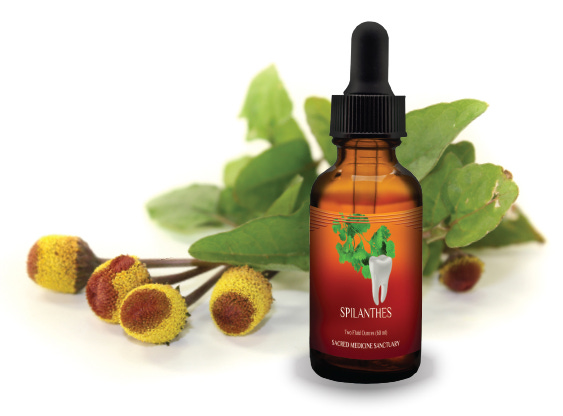Spilanthes has many nicknames. It is often called the toothache plant. If you chew the flowers, the flow of saliva is stimulated. Besides numbing pain, there is considerable benefit for the gums and oral health in general. One can also add the spilanthes extract to water irrigation devices or swish with some extract added to oil.
To-date, the coverage of oral health has been focused on the three ubiquitous hazards to which nearly all of us are exposed to some degree or other: mercury, fluoride, and radiation. To wrap up this topic, tooth and gum pain, peridontal issues, and choice of oral health care products will be addressed. Some suggestions for alternatives to amalgam and composite fillings will follow along with my protocol for regeneration of the teeth.
Many people consider toothaches to be one of the most painful experiences they have had, usually forcing dental appointments, sometimes on an emergency basis. On a Friday evening in 2018, I heard a crack while eating and the front part of an upper tooth separated and exposed the nerve. My dentist works Monday through Thursday. Spilanthes was invaluable during the seemingly endless hours that I waited to see him.
This is actually a big story because, having survived the weekend, I was in a stoic mode and forbid him to extract the tooth regardless of his professional opinion. He, of course, was totally aware of the pain, had not heard of spilanthes, but was convinced that the tooth would die since the nerve had been exposed. He said the front part was not attached to the tooth and was hanging on only because of the gum. We spent 45 minutes discussing a compromise. He bonded the tooth fragment to the adjacent tooth to hold it in place, and said that if my plan for regeneration worked, we would be creating dental history. When I eventually told him we had, in fact, succeeded, he was not interested and I have not seen him since.
Preparation
Many years ago, I was a guest at a seminar on oral toxicology hosted by someone I had helped through a life-threatening disease. I became aware of the internal structure of teeth and the tubules that nourish teeth. They are in the aquamarine area of this illustration² and are very tiny.
My goal was to regenerate the tooth. I knew it would take a long time, that I could only chew on the right side for an indefinite period, that any slip up would be excruciatingly painful and probably result in failure. I will describe the protocol in a future post. For now, the emphasis is on spilanthes because it got me through by making the pain manageable.
Spilanthes is in the same plant family as echinacea and causes a similar tingling sensation which can be quite surprising. It also promotes the production of saliva and has antiseptic properties that can resolve deep infections under the gums and even in the throat. Unlike analgesic drugs, most medicinal plants contribute to underlying healing, not simply to pain relief. So, the initial effects may be brief, perhaps only 10-15 minutes, but with repeated use, the relief lasts longer because the cause is actually being addressed.
Dental decisions can be very challenging so it is not wise to ignore complaints, but the flip side is that by extracting teeth, one is making an irrevocable decision and not testing the ability of the teeth to heal and regenerate. In my case, the tooth fracture took a little more than a year to regenerate.
Additional Uses for Spilanthes
The herb is native to the tropics, mainly Africa and Brazil, but can be grown indoors or in a greenhouse in other climatic zones. As with many tropical herbs, spilanthes has some antiparasitic properties and has been used in the treatment of malaria and co-infections of Lyme disease. It is also sometimes used directly on the skin to give temporary relief from pain.
Copyright by Dr. Ingrid Naiman 2023 || All Rights Reserved
Image Credit:
¹ Dreamstime: Yui Yuize
² Dreamstime: Mrhighsky
Available from: https://toxicteeth.com/product/spilanthes-extract-2-oz/
Owned and operated by the author.






